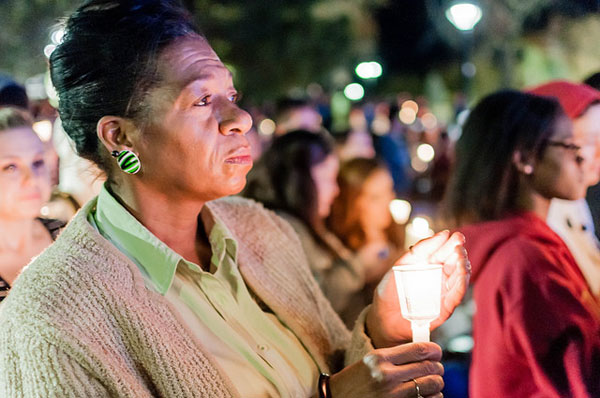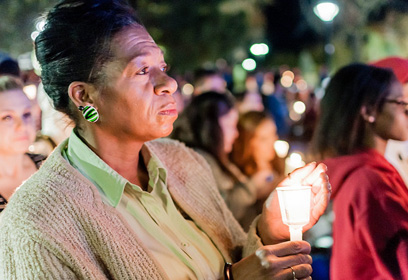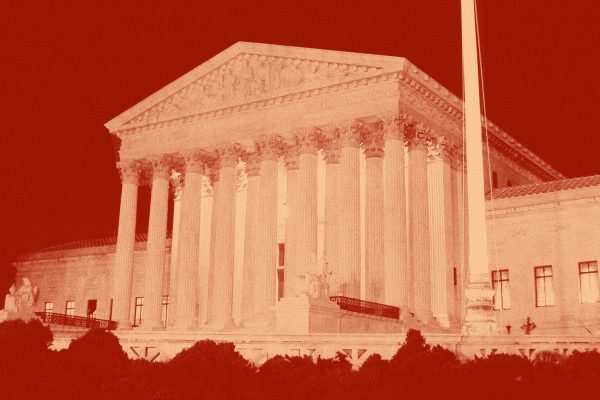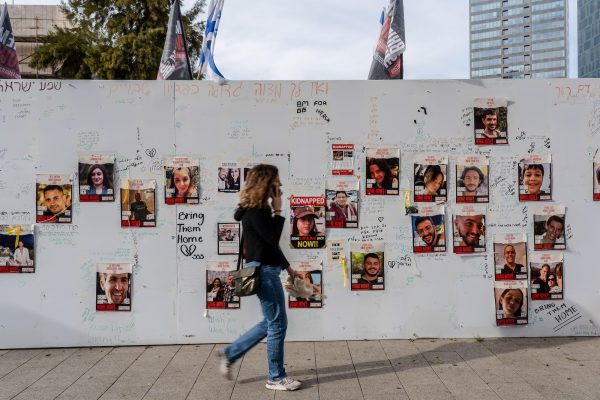
A woman holds a candle at a vigil for the fourteen people murdered when two shooters opened fire at the Inland Regional Center in San Bernardino, California, on December 2. / Steven Hall
Even before the victims were buried, warmongers in both major political parties—including many on the campaign trail—were trying to elevate the shooting in San Bernardino into another 9/11. Not usually given to rhetorical bombs, Jeb Bush declared, “This is the war of our time. . . . We need a wartime commander-in-chief who is ready to lead this country and the free world to victory.” Ted Cruz echoed that sentiment, telling the Republican Jewish Coalition that the shooting laid bare the need for “a wartime president.” Chris Christie warned that “the next world war” is already upon us. And though Hillary Clinton has thus far avoided the fear-laden term “war,” she did her best to channel Winston Churchill when she announced, “We have to fight them in the air, we have to fight them on the ground, and we have to fight them on the Internet.”
These politicians have it backwards. The gathering evidence about San Bernardino demonstrates how irrelevant the 9/11 mindset has become. Fourteen years ago, the attacks of September 11 were constructed as an act of war and an intelligence failure, rather than a crime and an investigative failure. On this foundation, the United States built the entire self-destructive architecture of the post-9/11 world, from the globally destabilizing wars in Afghanistan and Iraq to mass surveillance, from torture to indefinite detention. Regardless of whether this war-and-intelligence framing was appropriate for 9/11, it surely does not fit San Bernardino or the threat we currently face. Terrorism in the United States today is a crime—no more and no less.
The San Bernardino attackers assembled their arsenal relatively quickly, with apparent ease and without attracting the attention of the national security apparatus. Though they may have been inspired by ISIS, they were not part of a larger group or cell. And they attacked one of the millions of unprotected (and unprotectable) soft targets an open society will always contain. All of these factors expose the limits of the 9/11 framing, since no amount of military intelligence and no type of interrogation will allow the United States to identify and prevent this sort of violence, a realization that is slowly dawning on American policymakers.
Few policies invigorate extremism more than a program of indiscriminate repression.
Indeed, there was no intelligence failure. When President Obama assured the country the day before Thanksgiving that the United States had “no specific and credible intelligence indicating a plot on the homeland,” he was right. The intelligence community can no more uncover and disrupt an event such as the San Bernardino shooting than it could those earlier massacres at Sandy Hook, Aurora, Charleston, Oklahoma City, Tucson, or Columbine.
This in turn explains why politicians—especially on the right—have been simultaneously bellicose and vague. Mired in a 9/11 mindset, the GOP and its warmongers cannot sensibly construct the attack. They cannot assign it a meaning that fits the facts to their preferred framing. In this void, they content themselves with chest-thumping and finger-pointing. This will certainly be enough for a fraction of the population—the same fraction that flocks enthusiastically to Donald Trump and the like. But to mobilize the country behind their apocalyptic vision, Republicans need to connect the event to their ideologically driven idea of national security. They need us to believe we are not dealing with criminals but with enemies.
On behalf of that effort, we will naturally hear calls to close the border. How was San Bernardino shooter Tashfeen Malik allowed to enter the country? Ted Cruz and Alabama Republican Senator Jeff Sessions have already sent a letter to senior administration officials demanding “any immigration documents” related to her entry into the United States. Donald Trump wants to ban Muslims from entering the country.
But immigration is only one aspect of the debate. The attacks must also be constructed as a commentary on American Muslims. It has to be about them, in other words, not about us. The tradeoff between liberty and security has always come down to their liberty for our security. The right will thus intensify its argument that the Muslim community contains an unknown number of radicals, which many will continue to say is exceedingly high.
Because we cannot secure every possible target, the only sensible solution will be to monitor, contain, and strike at this population as aggressively as possible. The president of the evangelical Christian Liberty University is urging vigilante violence, suggesting that students obtain concealed-carry permits so they can “end those Muslims.” Constitutional lawyers might balk at Trump’s zeal to register Muslims and prevent them from entering the country, but his goal is not to promote policy so much as provoke anxiety. As the response to 9/11 demonstrated, nothing aggrandizes the national security state so much as fear of the enemy, whether in Mesopotamia or on Main Street.
But the constant talk of world war and porous borders misses an obvious fact: the mass murder in San Bernardino was a crime. Two people armed themselves, went into a crowded building, and killed fourteen fellow human beings. Was it also an act of terrorism? Of course it was, just as the mass shooting at a Planned Parenthood clinic in Colorado Springs was an act of terrorism; just as the murder of nine African Americans in a Charleston church was an act of terrorism; just as the killing of six people outside a Tucson supermarket was an act of terrorism. In each case, the attackers used lethal violence to dramatize an ideological position opposed to that which is legally and culturally dominant in society. If there is a definition of terrorism, that is it.
Recognizing these attacks as terrorism is thus the first step, not the last. People such as Timothy McVeigh and Terry Nichols in Oklahoma City, Dylann Roof in Charleston, Jared Loughner in Tucson, and Syed Farook and Tashfeen Malik in San Bernardino are indeed terrorists, but the label merely describes methods and goals; it does not translate into policy. Effective policy comes from a clearheaded examination of the behavior we seek to curb rather than a politicized attachment to terminology.
So what do we do? Lone-wolf terrorists are inspired by a hateful ideology but act on their own. The first challenge, therefore, is to delegitimize the ideology. Indeed, given the daunting practical challenge of identifying and preventing random violence, delegitimizing the ideology must be not only the government’s first goal but also its most important priority.
In a world that mythologizes the rule of law—where adherence to the law is the universal symbol of a just state—one cannot delegitimize an ideology simply by creating new legal forms to confront it. The legal infrastructure developed after 9/11 is a case in point: thanks to the lawyers, torture doesn’t violate the Convention Against Torture or the federal anti-torture statute; Guantánamo, despite all evidence to the contrary, is actually Cuban; the prohibition against cruel and unusual punishment doesn’t apply at foreign black sites; electronic surveillance to protect national security requires no warrant; and “enemy combatants”—a hitherto unknown legal category—have no rights at all. Yet this proliferation of self-exonerating legal chicanery has only validated the extremist ideology of radical Islam by reaffirming its essential charge that the West is hypocritical and morally bankrupt.
Likewise, no state has ever delegitimized an extremist ideology by ignoring the vital distinction between the violent few and the peaceful many. As President Obama has long emphasized—and as he reiterated in his address this week—few policies invigorate extremism more than a program of indiscriminate repression. Such campaigns inevitably sweep too broadly, whether they are carried out at home or abroad, under civilian or military direction.
Delegitimizing an extremist ideology is only part of our policy response. Law enforcement must also do what it can to identify would-be attackers. From the use of informants and immunity to the sophisticated tracing of illegal funds, there are tools the government can deploy—and that the FBI has often deployed against gangs and mafiosi—to infiltrate and dismantle criminal organizations.
But these tools have never been particularly helpful in preventing outbursts of random violence. For that reason, the FBI has also learned to swim in the extremist ideological stream. Law enforcement monitors social media and Internet sites used by ISIS. Undoubtedly this is a challenge, an endless cat-and-mouse game as users—innocuous and extremist alike—grow increasingly conscious of their online privacy and security. Yet a number of post-9/11 terrorism prosecutions began precisely through this monitoring.
As much to the point, the widespread use of digital communication does not alter the nature of the criminal behavior, nor does it make a military mindset more suitable to the task of preventing violence. Many crimes, such as child pornography, rely on clandestine Internet sites and chat rooms to facilitate communication between purveyors and purchasers, and law enforcement has ample capacity to exploit social media for prosecution.
Yet too many politicians, especially Republicans, miss all of this. Vacuous calls for “a wartime president” to wage “the next world war” show that the GOP is out of ideas. Whatever value there may have been in the intelligence-failure framing adopted after 9/11, it has no meaning in today’s world. If we hope to avoid another post-9/11 scenario, we should call this violence what it is: a crime, which should be investigated and prosecuted to the full extent, but within the limits, of the law.








